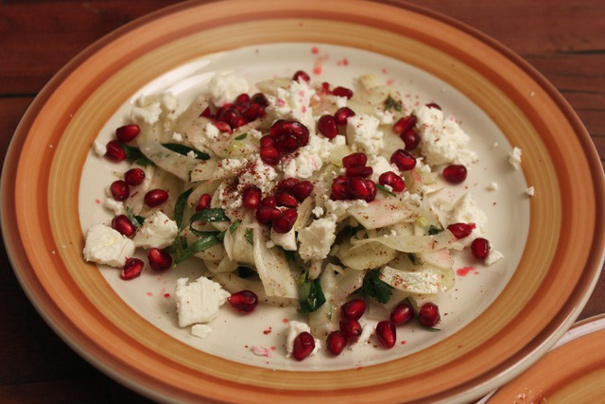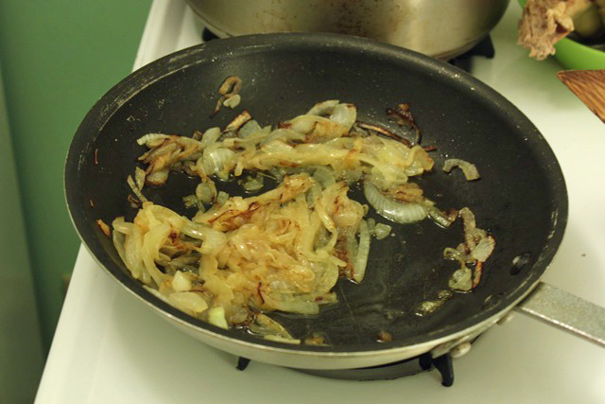Oh, Ottolenghi: Fennel and Feta with Pomegranate Seeds and Sumac / Couscous with Apricots and Butternut Squash
A year or two ago, my friends Lauren and Amy gifted me with a cookbook by Yotam Ottolenghi called "Ottolenghi: The Cookbook." And even though it's a beautiful, tall book with colorful pictures and herb-flecked recipes from Israel by way of London, I hardly ever used it. I made mental notes to cook from it--the sumac chicken, for example--but nothing ever happened. And then something did, finally, happen: Ottolenghi published another book, Plenty, that's all the rage now. Instead of running out and buying that, I reopened the Lauren/Amy Ottolenghi book and discovered a world of wonders within. I decided to cook two recipes from it for a dinner that I cooked for my friends Kenny and Brendan.
Here are Brendan and Kenny at the table:
You may recognize Brendan from his times out drinking with Martha Stewart; you may recognize Kenny as one of New York's premiere downtown cabaret artists. I met them both out east before journeying west; and though Kenny once wrote a guest post for my blog, I'd never made them dinner. That all changed when I cooked them Ottolenghi food.
Here's the wonderful thing about Ottolenghi food: it's big on flavor. And that flavor comes from simple ingredients that are combined in such abundance the results feel decadent, even if they're slightly virtuous. Take the fennel / pomegranate salad, for example. Here are the basic ingredients:
In the big red bowl you'll see 2 medium heads of fennel that have been cored and then shaved on a mandoline. In the bowl on the right you'll see seeds that I smacked out of 1/2 a pomegranate. (When I say smacked, I mean I cut it in half "along its 'belly,'" held it firmly in my hand with the seeds facing my palm over a bowl and whacked it with a wooden spoon---the seeds came shooting on out). In the bowl in the foreground, you'll see the makings of a dressing: 2 teaspoons sumac, 4 tablespoons tarragon leaves, 2 tablespoons chopped flat leaf parsley. To that I added the juice from one lemon and 1 1/2 tablespoons olive oil (a bit more, actually), some salt and pepper and tasted for balance.
To serve this up, you toss the fennel in the dressing and then plate that first. On top you sprinkle Greek feta cheese and the pomegranate seeds. You garnish with fennel fronds and sprinkle a little more sumac over everything:
Isn't that a gorgeous salad? And, again, it's both decadent and virtuous at once.
As for the couscous, I was making it as a base for my famous spatchcocked chicken with salsa verde (that's what you see Brendan and Kenny holding up in their picture). What intrigued me about Ottoelnghi's couscous is that it contains many "wet elements" to keep the couscous moist. So you saute an onion in olive oil until it's golden brown:
You roast a small, diced butternut squash in a hot oven until it's caramelized:
And you soak dried apricots in hot water to rehydrate them.
Then it's just a matter of cooking your couscous (I cooked mine in chicken stock that I intensified with the backbone from my spatchcocked chicken; simmering it for an hour or two before adding a pinch of saffron and, then, the couscous). Once your couscous is cooked you add everything else:
That would be the butternut squash, the chopped apricots, the sauteed onion, cinnamon, chopped tarragon, mint and parsley, lemon zest, salt and black pepper. You toss that all together:
And there you have a beautiful base for whatever you want to serve (in my case, chicken). And it really does do as Ottolenghi promises: it stays very moist because of all the wet elements.
So as you can clearly see from this post, I'm an Ottolenghi convert. The "Plenty" book will be on my Christmanukkah list and I'll be writing Amy and Lauren another "thank you" e-mail for buying me this book. It's a treasure I didn't even know I had.
[P.S. I'm typing up the couscous recipe because you'll want the details, but the fennel salad recipe is pretty much fully there above. Sumac is worth seeking out for it--it's a dark red, middle eastern spice that's strangely, wonderfully acidic. Try sprinkling some over hummus.]
Recipe: Ottolenghi's Couscous with Dried Apricots and Butternut Squash
Summary: A delightfully moist and flavorful couscous from the London chef.
Ingredients
- 1 large onion, thinly sliced
- 6 tablespoons olive oil
- 1/4 cup to 1/2 cup dried apricots
- 1 small butternut squash, peeled, seeded and cut into 2 centimeter dice
- 2 cups couscous [Note: original recipe calls for 250 grams couscous and 400 mL stock; this is my adaptation]
- 2 cups chicken or vegetable stock
- A pinch of saffron strands
- 3 tablespoons roughly chopped tarragon
- 3 tablespoons roughly chopped mint
- 3 tablespoons roughly chopped flat-leaf parsley
- 1 1/2 teaspoons ground cinnamon
- Grated zest of 1/2 lemon
- Coarse sea salt and black pepper
Instructions
- Preheat the oven to 425 degrees (Ottolenghi says "180 C or Gas Mark 4" but that's if you're British; that would work out to 350 F, but I prefer a higher temp for squash). Place the onion in a large frying pan with 2 tablespoons of the oil and a pinch of salt. Saute over a high heat, stirring frequently, for about 10 minutes, unti golden brown. Set aside.
- Meanwhile, pour enough hot water from the tap over the apricots just to cover them. Soak for 5 minutes, then drain and cut into 5 mm dice.
- Mix the diced squash with 1 tablespoon of the olive oil and some salt and pepper. Spread the squash out on a baking tray, place in the oven and bake for about 25 minutes, until lightly colored and quite soft.
- While waiting for the butternut squash, cook the cous cous. Bring the stock to the boil with the saffron. Place the couscous in a large heatproof bowl and pour the boiling stock over it, plus the remaining olive oil. Cover with cling film and leave for about 10 minutes; all the liquid should have been absorbed.
- Use a fork or a whisk to fluff up the cous cous, then add the onion, butternut squash, apricots, herbs, cinnamon and lemon zest. Mix well with your hands, trying not to mash the butternut squash. Taste and add salt and pepper if necessary. Serve warmish or cold.
Preparation time: 20 minute(s)
Cooking time: 40 minute(s)
Number of servings (yield): 4
My rating








